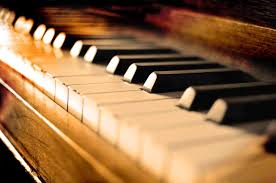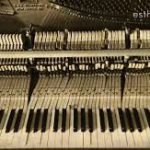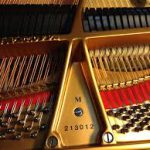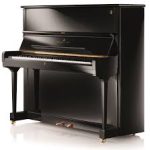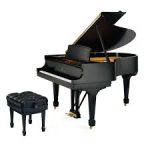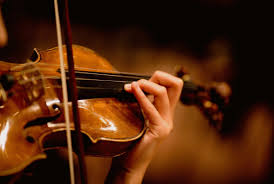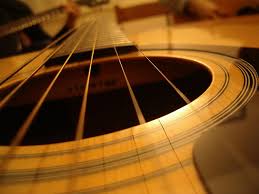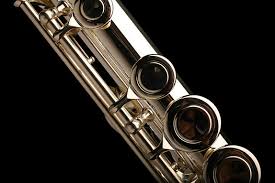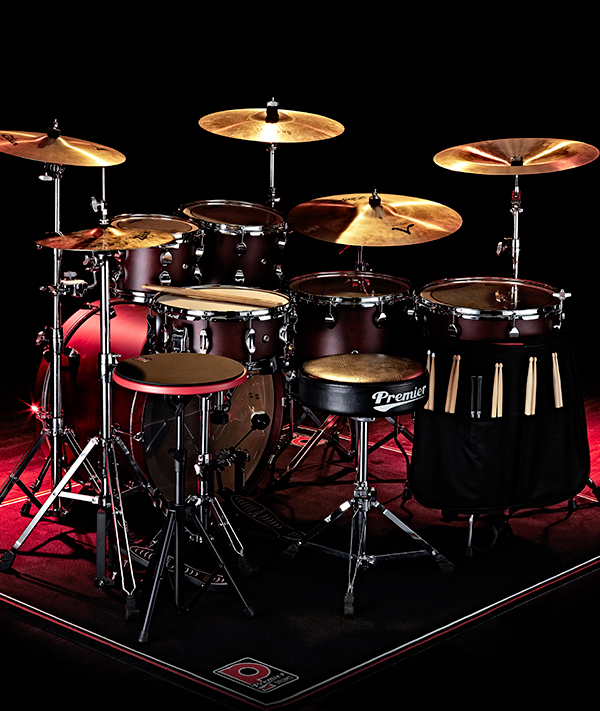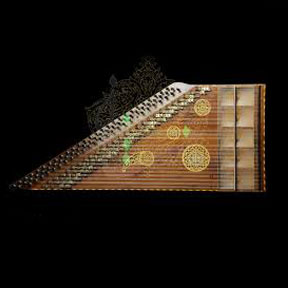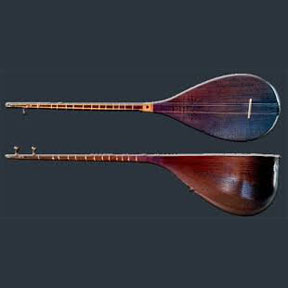The Piano
The piano is often referred to as the “mother of instruments” and the most complete instrument, due to its ability to produce a very wide range of sounds, unlike other classical musical instruments, which can only produce a portion of this sound range. The modern piano typically has seven octaves and can produce frequencies ranging from approximately 20 to 5000 Hz. In comparison, the violin can only produce less than four octaves, and even the best singers can sing less than three octaves.
The modern piano was invented by Bartolomeo Cristofori in 1709 in the city of Padua, Italy. Before the invention of the piano, an older instrument called the harpsichord was used. The major and important difference between the piano and its predecessors is that in the earlier instruments, the intensity of the sound produced by pressing a key was independent of the force with which the key was struck; the intensity was constant. However, with the piano, the player can create a softer sound by gently striking the keys or a louder sound by striking the keys harder. This feature quickly attracted the attention of 18th-century composers.
Piano Types
Grand Piano (Large, Concert, and Small Grand Pianos): In grand pianos, the strings are positioned horizontally inside the instrument’s casing.
Upright Piano: In this piano, which has a more compact casing, the strings are positioned vertically.
The ancestors of the piano can be traced to the clavichord and the harpsichord. In the harpsichord, each key is connected to a lever with a small, vertical piece of wood at the end, where a hook-like pen strikes the string to produce sound when the key is pressed. However, the sound dynamics do not change with the pressure applied to the keys.
The harpsichord generally has two rows of keys; one row produces only forte sounds, and the other produces only soft sounds. The sound of the harpsichord is crystalline and somewhat dry, while the clavichord produces a softer and more delicate sound. The internal structure of today’s pianos is similar to that of their ancestors, but more advanced and complex.
The piano is not typically an orchestral instrument but is sometimes used in orchestras for specific color effects. The higher sound range of the piano is bright and bell-like, while the lower notes are sometimes used to add percussive power and fullness to the bass line due to their dark, somewhat gong-like quality. The middle range of the piano is generally more neutral in color and is less interesting in an orchestral setting. In fact, writing piano parts for an orchestra is most successful when the usual solo piano patterns are avoided.
It should be noted that the piano is rarely used in orchestral compositions, even in contemporary works. When it is used, it is better to employ it sparingly, similar to the use of special orchestral instruments for color.
The best examples of using the piano in modern music can be found in Prokofiev’s Symphony No. 5 and Copland’s Symphony No. 3.
Keyboard Instruments
The piano, harpsichord, organ, and accordion are the most well-known keyboard instruments. The keys of these instruments allow the player to play several notes simultaneously, quickly, and easily. This shared characteristic justifies grouping these otherwise very different instruments into one family: the piano and harpsichord use vibrating strings, while the organ uses columns of air in sound pipes to produce sound. In the modern symphony orchestra, the piano and, to a lesser extent, the organ are used for coloring. All keyboard instruments can also be played solo.
In the last two centuries, more notable works have been composed for the piano than for any other solo instrument. The piano’s performance capabilities are uniquely diverse and wide-ranging. A pianist can play multiple notes, melodies, and accompaniments simultaneously. The piano can perform music across a wide range of sounds, and its 88 keys cover more than seven octaves. The dynamic range of the piano is also vast, from whisper-soft tones to loud, powerful sounds. It is due to this dynamic flexibility that the Italians named it the “pianoforte” (soft-loud).
When a pianist strikes a key, a felt-covered hammer moves toward the corresponding string and strikes it. The harder the key is pressed, the stronger the hammer strike and the louder the resulting sound. When the pianist releases the key, a felt damper falls onto the string to stop its vibration and silence the sound. The piano’s steel strings are stretched and held tight by an iron frame. Below the strings is a wooden soundboard that amplifies the vibrations and adds color to the sound.
The piano typically has three pedals. The most important is the sustain pedal on the right, which allows the pianist to sustain the sound even after releasing the keys. The soft pedal on the left, often called the “una corda” pedal, softens the sound and reduces its intensity. The middle pedal, the sostenuto pedal, is rarely used (and in fact, many upright pianos do not have it); this pedal allows the pianist to sustain some notes without sustaining others.
The piano, invented around 1700, became widely used in the 1780s and was mechanically perfected by the 1850s. Today, the piano is one of the most popular instruments and is used in solos, ensembles, and as accompaniment to other instruments.
The harpsichord’s strings are plucked by a series of small plectra (made of plastic, leather, or bird quill) controlled by one or two rows of keys. The harpsichord was the most important stringed keyboard instrument from around 1500 until 1775 when the piano gradually replaced it. Although the harpsichord was largely forgotten in the 19th century, it regained popularity in the 20th century with the performance of pre-1750 works and has found new use in the compositions of 20th-century composers.
The church organ (pipe organ) has multiple sets of pipes, controlled by several rows of keys and a row of foot pedals. The keys open and close valves at the pipe openings, allowing or stopping the flow of air through the pipes. By pulling out stops (or manual levers), the organist can access a variety of pipes for musical performance. Each set of pipes has its unique sound color, which can be played alone or combined with other sets. The larger the organ (with more sets of pipes), the more diverse its sound colors.
Unlike pianists, organists cannot create subtle dynamic changes by varying the pressure on the keys. Instead, dynamic changes are achieved by increasing or decreasing the number of pipes, moving from one row of keys to another, or opening and closing shutters (like venetian blinds) around each group of pipes. The sound of the organ continues as long as the key or foot pedal is held down.
The golden age of organ building and composition for the organ was from 1600 to 1700, a time when the organ was considered the “king of instruments.” Although the organ has primarily served religious ceremonies, it is now also found in many concert halls and used in performances.
The accordion has free steel reeds that produce sound when played with piano-like keys (on the right hand) and a set of buttons (on the left hand) for bass notes. The reeds vibrate with the air pressure created by the bellows of the instrument.
Physical Structure
The full name of the piano is “pianoforte,” which consists of two parts: “piano,” meaning soft, and “forte,” meaning loud, reflecting the instrument’s ability to produce various intensities of sound.
Early pianos were large and had a distinctive shape. The instrument commonly referred to as a “grand piano” (often incorrectly called a “royal piano” in Iran) is usually over two meters long and has a large lid that is often left partially open during performance to enhance the sound. Other types of pianos, such as the upright or square pianos, are smaller.
The piano’s hammers are connected to the keys through a series of delicate levers known as the piano’s action. The action’s purpose is to increase the hammer’s speed as it strikes the strings and to control the hammer’s rebound after the strike. The hammers are usually covered with a layer of felt or similar material to improve the quality of the piano’s sound. The sound quality of the piano is also influenced by factors such as the quality of the soundboard.
Each octave on the piano has seven white keys for the notes C, D, E, F, G, A, and B. In addition to these white keys, there are black keys between some of the white keys. There are no black keys between the white keys E and F or between B and C. Each black key can be considered either a sharp note for the white key to its left or a flat note for the white key to its right.
The Internal Structure and Mechanism of Acoustic Pianos
Although grand pianos and upright pianos differ in overall structure, they share several similar components and functions. The following are key parts of these pianos:
Frame: The frame is the skeleton that holds the internal components of the piano. Frames are usually made of wood but sometimes reinforced with iron bars for added strength. In grand pianos, the frame is visible from underneath, and in upright pianos, it is visible from the back.
Soundboard: The soundboard is one of the most critical parts of a piano. Its function is to amplify, resonate, and project the sound produced by the strings. This part, made of a wooden plate approximately 10 millimeters thick, vibrates with the strings to amplify the sound. Strips of wood called bridges are attached to the soundboard, holding one end of the strings in place. The soundboard is positioned parallel to the strings in grand pianos and vertically behind the strings in upright pianos.
Cast-Iron Plate: The cast-iron plate is used in modern pianos to withstand the high tension of the strings, which ranges from 15 to 20 tons. This part, often painted gold, is located between the strings and the soundboard and forms the front part of the piano. The plate has holes, and the strings pass through them. The soundboard is connected to the wooden frame of the piano.
Strings: The strings in a piano are made of tightly wound steel. The thickness of the strings determines the frequency of the sound produced, with thinner strings producing higher sounds and thicker strings producing lower sounds. Each note is produced by three strings, except for the lower notes, which are produced by one or two thicker strings.
Keys and Action: The action is the heart of the piano, containing all the essential components like keys, hammers, dampers, and the parts connecting them. Each key is a lever that controls the hammers and dampers through a complex set of parts. When a key is pressed, a hammer moves toward the corresponding string and strikes it, causing it to vibrate. The dampers, made of felt, return to their resting position after the key is released, stopping the vibration and silencing the sound. The sustain pedal (right pedal) allows the pianist to hold the dampers off the strings, letting them vibrate freely even after the keys are released.
Pedals: Modern pianos typically have three pedals:
Sustain Pedal (Right Pedal): When pressed, this pedal lifts all the dampers off the strings, allowing them to vibrate freely and sustain the sound even after the keys are released.
Soft Pedal (Left Pedal): When pressed, this pedal shifts the entire action to the right, causing the hammers to strike only one or two of the strings for each note, creating a softer sound. It is often referred to as the “una corda” pedal.
Sostenuto Pedal (Middle Pedal): This pedal, found in some pianos, allows certain notes to sustain while others do not. The sostenuto pedal is rarely used and is often replaced by a practice pedal in upright pianos.
Keyboard: The keyboard consists of white and black keys, arranged in groups of seven white keys and five black keys per octave. The white keys represent the natural notes (C, D, E, F, G, A, B), while the black keys represent the sharps and flats. The black keys are grouped in twos and threes, with the gaps between the white keys corresponding to the absence of black keys between the notes E-F and B-C.
Music Desk: The music desk is a stand on which sheet music is placed. It is usually attached to the front of the piano’s lid or case and can be adjusted in height and angle.
Lid: The lid is the top cover of the piano. In grand pianos, the lid is often left partially open during performance to enhance the sound projection. The lid can be fully opened, partially opened, or closed.
Piano Stool: The piano stool is an adjustable seat used by the pianist. It is often made of wood or metal and may have a padded seat for comfort.
The History and Development of the Piano
The piano has a rich history that dates back to the early 18th century. It was invented by Bartolomeo Cristofori, who sought to create an instrument that could produce both soft and loud sounds. The early pianos, known as fortepianos, were small and had a lighter touch than modern pianos. They were popular among composers like Mozart and Beethoven, who wrote many of their works for these early instruments.
The piano continued to evolve throughout the 19th century, with improvements in its construction and mechanics. The introduction of the iron frame, felt-covered hammers, and the double escapement action allowed for greater dynamic range and expressive possibilities. Composers like Chopin, Liszt, and Brahms took full advantage of these developments, writing music that pushed the limits of the instrument.
In the 20th century, the piano became a central instrument in a wide range of musical genres, from classical and jazz to popular music. The invention of the electric piano and the synthesizer further expanded the piano’s role in music, allowing for new sounds and styles.
Today, the piano remains one of the most versatile and beloved instruments in the world. It is used in solo performances, chamber music, orchestras, and as an accompaniment to singers and other instruments. Its ability to produce a wide range of tones and dynamics makes it an essential tool for composers and performers alike.

